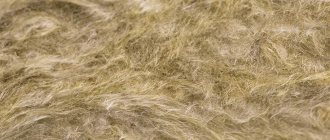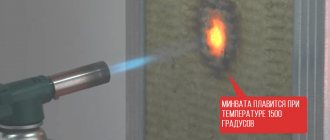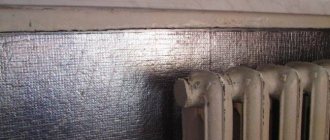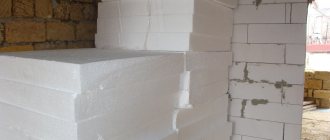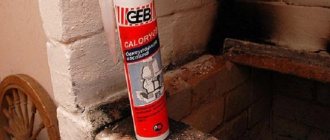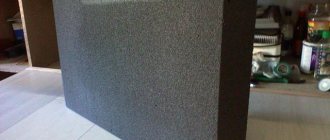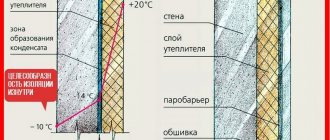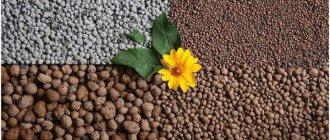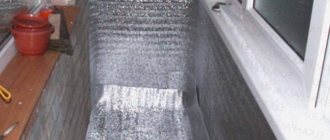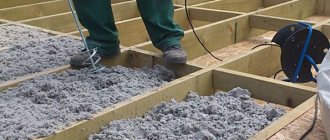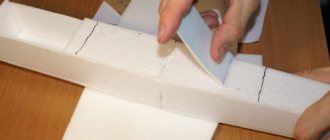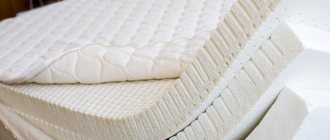What's happened
Penoizol insulation is a modified version of polystyrene foam. Its composition is quite viscous, so it is often compared to marshmallow. The entire material is foamed plastic, which has a cluster structure. Due to its unique properties, it is often used as a thermal insulation material.
Penoizol sheet insulation
Usually it is not used in finished form in global construction - it is made directly on the site itself. The mixture turns out to be liquid, so it can be used to fill all the voids in roofs and ceilings, which means the material is perfect for insulation.
The manufacturing process itself also allows you to save on foam insulation insulation , since in this case it is possible to save money, as well as resources for delivering the insulation and performing loading and unloading operations.
There is also no need to incur the costs of storing products of this type.
Characteristics and properties
As mentioned earlier, at the moment the material is considered one of the best insulation materials in the construction industry. This effect is achieved due to the improved parameters of the thermal insulation material. Important characteristics of penoizol :
- High thermal conductivity. These values are in the range of 0.03-0.4 W/mK. To keep the house warm, only 10 cm of sheet foam insulation .
- Sound insulation - average values reach 65%.
- Fire resistance. If there is a fire in the room, this material will not ignite. It is also melt resistant. If the fire continues to affect the material for a long time, it will eventually begin to evaporate gradually - no toxic substances are released into the air during this process.
- Resistant to moisture. Even if there is a large amount of water ingress, the heat insulator will be able to absorb it and release it back. The material absorbs up to a fifth of all moisture - then it gradually evaporates it.
- Durable coating.
- Suitable for insulating a house with foam insulation even with temperature changes.
Self-installation of the installation
Foam concentrate drawing.
(Click to enlarge) On the websites of manufacturers involved in the manufacture of equipment for the production of penoizol, you can purchase installation drawings and learn the production technology.
By purchasing such a package of documents, you can assemble this device yourself, especially since spare parts are always available.
A budget option would be a self-assembled structure consisting of:
- gas-liquid installation;
- set of taps;
- supply hose;
- compressor for producing compressed air;
- plastic barrels up to 300 l.
The process of obtaining insulation is based on the principle of foaming solutions with a catalyst and mixing it with urea resin. Using a pump, the components enter the installation, where they foam under the influence of compressed air.
Diagram of a foam insulation installation. (Click to enlarge)
One of the main system components in a gas-liquid installation is the pump, so it is better to purchase a quality pump.
We do not recommend pumps of type NSh 6 (gear pump) and NSh 10, as they can fail in dosages when supplying one of the components - resin.
These pumps also have problems with the electric motor. The declared power may not be enough to supply the finished product to fill voids.
Please take into account: when choosing pumps for installation, it is necessary to take into account errors in dosage, errors in engine speed instability depending on voltage and load.
It is more profitable to use plunger pumps or vortex pumps. Here it is no longer possible to make a mistake with the dosage, but if solid particles enter, the entire work process may be disrupted, from a failure in the dosage to a breakdown of the unit.
Keep in mind: when choosing a plunger or vortex pump, you must consult about the material from which the internal parts are made. It is desirable that it be nickel plated, stainless steel, ceramic or plastic.
It is also advisable to purchase a high-quality plunger pump for supplying foam. Foam is formed using a high expansion foam generator at low pressure. The output is foam with a beautiful fine-cell structure.
The most effective method today is double foaming. At the outlet, Penoizol appears as a dry mass, which makes it possible for it not to leak out of the cavity being filled.
The compressor on the equipment must be installed with a certain capacity
Be sure to pay attention to the resin consumption, it should be no more than 25 kg to get a quality product
Ready penoizol
In an installation for the production of penoizol, it is necessary to create an optimal ratio of all components to distribute the insulation throughout the entire filling volume.
The final product should be white and, when pressed, should return to its original shape.
As an insulating material with low cost and high insulating properties, penoizol is beneficial for your own production.
Having assembled the equipment according to the drawings, you can open your own small business and start earning money. With the expansion of the scope of penoizol, its production can be called promising.
Watch the video, which shows in detail the stages of working on equipment for penoizol with your own hands:
Advantages and disadvantages
Insulating walls with foam insulation is very popular, since it itself has a number of advantages that distinguish it from other materials. Of these, the following advantages are worth highlighting:
Insulation with penoizol
- Low level of thermal conductivity.
- Elastic material with a high elasticity index - with this advantage it is possible to completely fill cracks in the walls and voids;
- Protection from mechanical damage - if force begins to act on the finished solution, it is first pressed down a little. And after that it returns to its original form.
- Adaptation to high levels of humidity, as well as the ability to tolerate sudden temperature changes.
- Vapor permeability - this property allows you to completely get rid of condensation;
- Adhesion - the solution is suitable for any coating, so filling with foam insulation is suitable even for complex structures;
- The material is resistant to fungus and mold, and living organisms will not grow here;
- Affordable price - the base for penoizol itself is inexpensive, which is why the finished material is considered one of the cheapest on the market. If the building owner has the skills, then you can save on the costs of insulating the house if you do everything yourself.
- Long service life - on average, such material will last a home about 50 years;
- The base is environmentally friendly - even when burning, the material does not release toxins, so it is considered as safe as possible.
However, even such a durable and reliable material has a number of disadvantages that must be taken into account when choosing insulation. The disadvantages of penoizol are the possibility of shrinkage of the material - about 5%.
Users also note that to apply this solution you will need specialized equipment for penoizol - without it it will simply be impossible to do this. Such a device can either be purchased at a hardware store or rented.
Another disadvantage of this material is the high level of moisture absorption, easy rupture of the material, as well as difficulties when working at temperatures below five degrees.
Insulating a house with liquid foam insulation
DIY penoizol: home laboratory
Finding a liquid polymer for spraying is not as easy as we would like, so let’s consider a way to prepare a working solution yourself. What you need to prepare:
- Urea-formaldehyde resin;
- Foaming agent;
- Technical tap water;
- Orthophosphoric acid.
The ingredients can be purchased at a hardware store or chemical supply department.
Please note that the components have a short shelf life (only a few months). To obtain normal working foam, you need to take only fresh raw materials
Otherwise, the insulation will be unstable, the layer will crack and shrink significantly.
The proportions of the components for making the solution, depending on the desired characteristics of the foam, may be different. If necessary, more resin and acid are used in dense foam insulation; accordingly, less material is taken for loose foam.
To prepare 1m3 of penoizol you will need:
- Resins 6...70 liters (more resin - denser foam). The material is heated to 20°C or more; there is no need to filter or control the viscosity;
- The water is heated to 20 degrees or more. You can use regular tap liquid. Its quantity is determined conditionally until the foam reaches the desired properties, the guideline is approximately the same volume as the resin;
- Foaming agent alkylbenzenesulfonic acid (ABSA) in an amount of 0.5...1.0% of the total volume after mixing the resin and water;
- The catalyst - orthophosphoric acid is taken in an amount of 0.2...0.5% of the total volume.
To produce penoizol brand M15, take:
- Resin = 20 kg;
- Water = 24.5 kg;
- Foaming agent = 0.1 kg;
- Acid = 0.4 kg.
- Additives to reduce cracking - resorcinol (50 g).
The components for penoizol are mixed and poured into the spray container.
Kinds
There are several types of penoizol for various types of work. The most popular of them are the following:
- Liquid penoizol - this type is most often used in the construction industry, since among specialists it is considered the most convenient. It is manufactured immediately at the construction site using special equipment. It can also be purchased in special cylinders if there is no need for extensive work. This type is suitable for filling gaps when renovation work is being carried out in buildings.
- Leaf variety. To obtain such material, liquid foam is poured into special molds. Then the mass hardens and is cut into layers of a certain length. After this, the material must be dried and cleaned. Some companies also offer customers special foil foam insulation. It will not be possible to use glue, since such sheets must be installed using dowels. A cladding must be installed on the surface.
- Chit. This type of penoizol is obtained by crushing a finished solid sheet of material. Its size should not exceed 15 mm.
Distinctive features of materials
Thermal insulation with foam insulation has its advantages:
- quick insulation of both small and large areas;
- there is no need to install an additional base, profiles, membranes, vapor and waterproofing films;
- are not subject to rotting and mold formation;
- have a high degree of fire safety (not flammable, but can melt);
- interacting with metal, they provide a corrosion-resistant coating;
- have a uniform seamless structure;
- optimal heat-saving characteristics.
Therefore, it is difficult to talk about environmental and operational parameters. Among the disadvantages of foam insulation, it is worth noting the following:
- do not tolerate exposure to sunlight;
- waterproofing properties are not ideal
- This material requires compliance with application conditions: you need a special canvas suit, gloves and goggles with a mask.
- Due to the rather low degree of vapor permeability in the room, a thermal effect is formed, so it is necessary to ventilate the room well.
For example, if we compare thermal conductivity, polyurethane foam is much superior to penoizol (the coefficient of the first is 0.019 W/m-k, and the second is 0.040 W/m-k). The density of the material characterizes the ability to operate under loads. Penoizol indicators are about 15 kg/m3, the density of polyurethane is approximately 25 kg/m3.
During standard operation, PPU insulation and penoizol are approximately the same (service life is about 50 years). In terms of price characteristics, polyurethane foam costs approximately 30% more than penoizol.
Thus, when choosing foam insulation, you need to take into account specific parameters for each individual situation.
Watch the video, which uses the example of a specific brand to discuss the features of working with foam insulation in cylinders:
Application and equipment
As mentioned earlier, penoizol is actively used in the construction industry. In some cases it serves as thermal insulation, although sometimes it is installed to reduce noise levels in the building. If we talk about a specific application, then with its help they insulate:
- External walls;
- Building facades;
- Roofs and roofing;
- Pipeline system;
- Vegetable storage facilities.
They also prefer to use the material for the manufacture of sandwich panels. If we are talking about penoizol, which is sold in granules, then it is suitable for horizontal structures. These can be attics in a house, floor surfaces and ceilings in high-rise buildings. The foil type is most often used for water pipes.
Pipeline insulation with foam insulation
If specialists choose a liquid type of foam for repair work, then you need to understand that there are some limitations. For example, it cannot be used where large amounts of liquid accumulate.
Examples of such premises include basements, basements, and the foundation of a building. The material itself will withstand temperature changes and freezing. However, over time, the effectiveness of its thermal insulation will decrease.
If you decide to finish the roof threshold, then it is also better to choose a different thermal insulation material. If the sun's rays constantly fall on it, the material will eventually lose all its basic properties, including heat and sound insulation.
Technical characteristics of penoizol - list
- thermal conductivity coefficient according to MCE – from 0.028 to 0.044 W/m*Kelvin;
- compressive density at relatively weak (no more than 10%) deformation – 0.003 MPa;
- resistance to temperature changes in degrees ℃ – from +70 to 55 with a minus sign;
- the volume of suspended particles of liquid and volatile ingredients is not higher than 12%;
- tolerance to aggressive environments – mold and fungal growths;
- acoustic barrier and noise reduction potential – from 20 to 60 decibels;
- the average density of a thermal insulation cushion is from 10 to 30 kg/m3;
- compression level providing support for the initial shape - 0.07-0.55 kg.cm2;
- repels small insects, voles, rats, and other pests;
- sorption humidification during the day (24 hours) – no more than 20% (twenty);
- resource guaranteed by the manufacturer – from 75 (min.) to 120 (max.) years.
Price
One of the advantages of this material is not only that it is considered environmentally friendly, but also the low price of penoizol . Moreover, if you compare its main advantages over other types of thermal insulation (resistance to mechanical damage, protection from rodents and insects, moisture resistance), then the prices will seem more than profitable.
In this case, pouring occurs immediately at the construction site. This allows you to reduce most of the costs of storing material. If we talk about average prices, then 1 cubic meter of solution costs about 1,900 rubles.
If a solution of higher density is used, the price will be from 2200 rubles. In some cases, the calculation is carried out depending on the area. In this case, the price is about 200 rubles per 1 sq. m. meter.
Floor insulation with foam insulation
Details about the characteristics
About the ability to conduct heat
The thermal conductivity of this insulation is very low - its coefficient ranges from 0.031 to 0.041 watts per meter per Kelvin. If you line the walls with just a ten-centimeter layer of this material, the house will immediately become warmer. Thanks to this, heating will cost several times less. So all costs associated with insulation are fully compensated for in one winter. The layer of penoizol can be from 5 centimeters to one meter. What it should be like is decided by the owner of the house.
About fire resistance
The flammability group of penoizol is defined as G-1, and the flammability group is B-2. This means that this material compares favorably with most polymers - it not only does not catch fire, but does not even melt from fire. In terms of smokiness, it is assigned group D-1, and in terms of toxicity - group T-1. This insulation can be used in a wide temperature range: from minus 60 to plus 80 degrees Celsius.
Let's imagine this situation: the ambient temperature is such that even the metal has melted. What will happen to penoizol? It's okay - it will just evaporate quietly, without releasing any harmful substances. As for smoke, during an open fire it is released 10 times less than that of expanded polystyrene (foam plastic).
About chemical and biological resistance
Many heat insulators are afraid of mold, becoming covered with a black coating in a humid environment. But penoizol does not attack any fungus, as well as other microorganisms. Mice and rats, who love to chew through several passages in the insulation, also do not touch penoizol. It does not react at all to organic solvents and chemically aggressive environments. So, they can safely insulate attics and basements - nothing will threaten your products.
About moisture absorption
Penoizol absorbs water well, but also releases it without any consequences. In this way, it differs for the better from mineral wool, the quality of which deteriorates after getting wet and drying. And at least it’s okay for penoizol – when it dries, it holds heat just as well. Moreover, it absorbs no more than 1/5 of the moisture, subsequently evaporating it. Therefore, where this material is used, the walls will not become damp, but a gap for ventilation must also be provided. Otherwise, fungus and mold cannot be avoided.
Since penoizol is hygroscopic, the walls of the room insulated with it are able to “breathe” freely. This provides comfortable conditions for the people living in the house. However, this is also very useful for the walls themselves - they collapse more slowly. During the day, the insulation absorbs moisture from 10.5 to 20 percent.
About the ability to pass air
The air passes through structures insulated with foam insulation. In this case, the humidity in the room is regulated itself, without external influence. Living in such a house is very comfortable - with a constant flow of fresh air, as well as an optimal ratio of heat and moisture in it.
About strength
The materials of the foam group are very technologically advanced due to their special softness. Due to this, they adhere well to all the unevenness of the building structure - it is enough to crush the material a little. Therefore, no gaps or voids are formed, and the level of thermal insulation is at its best. But penofol has very weak strength or bending strength and breaks with little effort.
Now let’s list the technical characteristics of penoizol in terms of strength. So, if you apply a linear ten percent deformation to it, then the compressive strength will range from 0.07 to 0.5 kilograms per square centimeter. When bending, this indicator will be from 0.1 to 0.25, and when stretching, from 0.05 to 0.08 kilograms per square centimeter.
We recommend exploring – Kitchen
About durability
Through experiments during which the durability of penoizol was studied, it was possible to establish that insulation applied to vertical-type structures can last from 30 to 50 years. This is confirmed by data obtained by analyzing the use of similar polymers in construction.
Penoizol in cylinders
The standard form of this material is a liquid that only takes a couple of hours to harden in an open area. At the same time, the liquid state allows you to fill all the cavities that are in the walls, which means making the building warmer.
If we compare several types of penoizol, we can conclude that penoizol in cylinders is much more often used in the construction industry, since it is considered the most suitable for most repair work. The following advantages of this type are highlighted:
- Thermal insulation properties of the material. If we compare penoizol in cylinders with other types of thermal insulation, then its properties are some of the best than those of any other base. At the same time, the material retains its effect even if the temperature reaches -70 or +200 degrees. Another advantage is the cost of such heating - it will be much lower compared to other heating materials.
- Easy material to use. Gas cylinders with penoizol are sold in almost every hardware store, since almost anyone can handle them. Moreover, most often apartment owners need a small amount of material - such packaging can fully satisfy their needs. If there is a need to use a large batch of mortar, then it is best to rent special equipment that will allow you to create the mortar on the construction site. In addition, this material easily fills all the cracks and cavities in the wall, roof, floor so that the surface itself retains its original appearance.
- Universal material. The functions of the solution do not end only with its use as thermal insulation. The liquid mixture can perfectly replace liquid nails if it is necessary to install another material as thermal insulation.
- Penoizol is resistant to temperature changes and climatic influences. Also, this material will never become covered with mold or mildew. And rodents will not be able to harm him.
Installer reviews
The characteristics of penoizol determine its method of application. After the mass comes out of the unit’s sleeve, it hardens. However, this process occurs gradually. The material sets to the base 10 minutes after application. In this state, penoizol remains soft.
After another 4 hours, the mass hardens. It becomes quite hard. However, penoizol has not yet gained strength. It will take a few more days for the thermal insulation to be ready for subsequent finishing. It gains strength within 3 days. During this time, Penoizol acquires all its positive qualities.
Professional installers claim that thermal insulation of this category is installed much faster than other insulation materials. The surface processing speed will be 4-5 times higher. Moreover, the material is lightweight. It slightly makes the structure heavier.
Penoizol production
Equipment for the production of penoizol
If you look at the penoizol production , then all its stages are quite simple. There is no need to incur large costs for equipment and manufacturing, and a small list of elements is used in the process. The technology includes the following stages:
- The components that form the basis of the solution are mixed in the container: foaming agent, catalyst and water. At the same time, prepare a solution in a second container - it is filled with urea-formaldehyde resin. After this, the mixture from the second container is combined with the first under the influence of compressed air.
- Mix all the elements so that the result is something like a soufflé. Here we get just liquid penoizol, which can already be used in further construction.
- To make hard sheets, you need to pour the resulting composition into molds and leave for some time to harden. Usually 30-40 minutes are enough for this (sometimes you will have to wait up to 3 hours). The time period depends on the size of the material and its shape.
- After the sheets are ready, they need to be cut into several parts. If it is necessary to improve some of the characteristics of the sheets, they are additionally coated with a special solution.
- After this, the finished product is packaged and prepared for storage.
Description
Sprayed polyurethane insulation Polynor is a completely new class of materials designed for insulation and sound insulation. It is very reliable, environmentally friendly, easy to use - it is often used to process areas of complex shapes and the most inaccessible places. Packaging in cylinders allows you to purchase exactly as much insulation as you need for the required work. The rate of insulation of one square meter is 2 minutes by one person
Advantages:
- seamless insulation, no cold bridges;
- no preliminary leveling of the surface is required;
- 100% adhesion to all building materials;
- adjustable insulation layer thickness from 1.5 cm;
- surface protection from fungus and mold;
- maximum penetration into joints and crevices;
- no weighting of the supporting structure;
- does not allow or absorb moisture.
